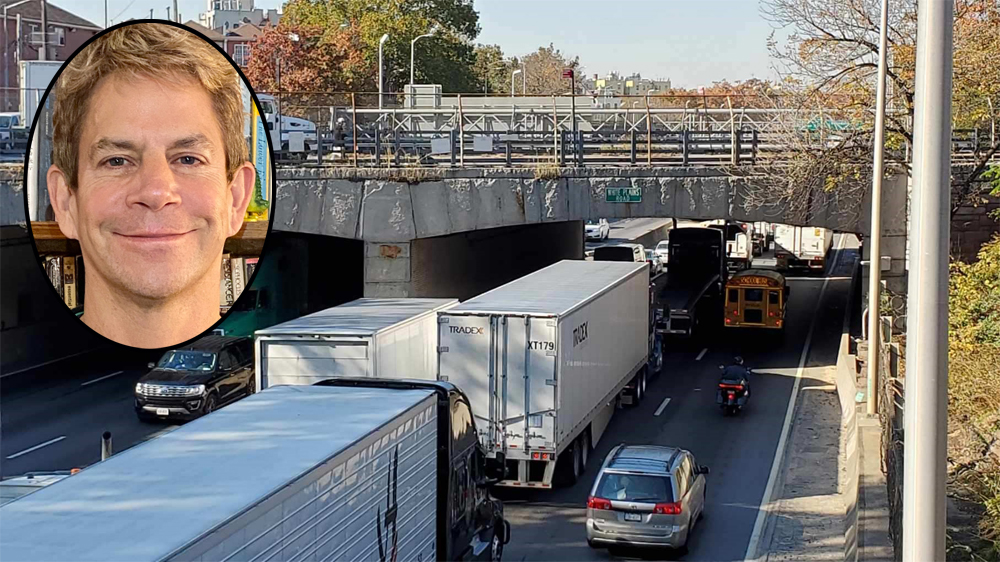Casting a ballot on Election Day has always been important, but it has never been quite enough to meaningfully transform the lives of everyday New Yorkers. The story of the effort to deck over the Cross Bronx Expressway illustrates why.
The Cross Bronx Expressway was one of the most expensive infrastructure projects in U.S. history, costing hundreds of billions in today's dollars. It cut through harmonious neighborhoods that were integrating. The intent was to tear them apart — and it worked.
You know the rest: the expressway cut the Bronx into two pieces, the North Bronx, and the South Bronx. The resulting pollution and noise were too much for some residents to take, and many moved out.
Soon after, the Bronx, which once had one of the densest populations of colleges and universities in the nation, became a national symbol of decay. Presidents Carter and Reagan campaigned on fixing the social problems in the Bronx. Ed Koch put a Band-Aid on the problem by investing in affordable housing within the burned-out neighborhoods, but to fix the problem, the expressway has to go.
How do we get a seemingly impossible job done? Voting helps because having unsympathetic politicians in office is a non-starter. But we need much more than that. We need innovative ideas, we need data to support the idea, and we need community activists to push the ideas through. In short, we need Streetsblog readers like you to first do the hard work of showing why your ideas work, and then get out into the community.
In the case of the Cross Bronx Expressway, the innovative idea is to cover it with greenspace rather than take on the impossible task of removing it. The activism arose from Loving the Bronx, an organization led by Nilka Martel. She sprang into action when she learned of a Columbia University study found that parks built on decks would also save money and lives over the long run. Realizing that elected officials might jump at a project that pays for itself, she reached out to both local and congressional leaders who then pushed the idea up to the political chain.
What is the big hook for politicians? The massive quantity of air pollution produced by the expressway means that residents suffer from chronic diseases like asthma and cancer. Fine particulate air pollutants are probably the world’s leading underlying cause of death. Like cigarette smoke, they enter the bloodstream through the lungs, causing rapid aging of the body, heart disease, cancer, stroke, asthma, and a host of other biological problems.
The noise also produces insomnia and mental illness. There is little space for exercise or active commuting to relieve the stress of constant traffic.
Fixing these problems reduces health costs and improves worker productivity. In fact, it produces a return on investment.
With the idea, the data, and the voice, #capthecrossbronx moved from Rep. Richie Torres to Sen. Charles Schumer and then on to Secretary of Transportation Pete Buttigeig. These leaders tapped into federal funding to start the process of assessing deck parks over the expressway using a federal RAISE grant in part to solicit community input as to how the caps will be built within each community.
But that is far from the end of the story. Community input is crucial for the community to “own” its own design, to determine what types of parks or other buildings would ideally go on the caps (community centers, playgrounds), and to redesign traffic flow. That is a big chunk of what the two-year study will do. If successful, about $1 billion will be allocated to building the caps. But we need more than input on their design and use. So, more innovative ideas and more input is needed by people like you.
There are plenty of problems still to be solved. If the caps are combined with a means for filtering the air, they will bring relief to everyone in the greater New York City metropolitan region. But any relief is still years away. Community leaders tend to favor the process of deliberation and planning because it ensures that their voices are heard. It also makes sure that the project is done right. But there is no safe level of PM 2.5, so we need to figure out how to save lives as the deliberative process unfurls.
A group of students at Columbia University’s Graduate School of Architecture Policy and Planning in conjunction with the Mailman School of Public Health proposed to solve this problem by mass-producing custom caps off-site. Materials science offers new ways of making caps using lighter-weight composites while greatly speeding up the construction process. Another idea they had was to use special cement coatings to neutralize air pollutants inexpensively. These pollutants include nitrogen dioxide and volatile organic compounds. By allowing the caps to be manufactured during the deliberative process, it is possible to expedite the remediation of pollution without interfering with the process of deciding what goes on top of the caps.
But these are just some of the problems and a few ideas for solving them. More people are needed to bring the project to fruition.
Placing caps and air filtration units over the Cross Bronx Expressway will heal the wound that separates the Bronx into the North and South, increase opportunities to exercise, reduce air pollution, and reduce noise. It is an idea that is better than anything past presidents could devise. By working with community organizations and elected officials, you can amplify your vote on Nov. 8. A magic wand to wipe away the wrongs of the past while also addressing one of the biggest public health threats in New York City? It seems like a no-brainer, but it can’t be realized without your hard work.
Dr. Peter Muennig (@PeterMuennig) is a professor of health policy and management at Columbia University’s Mailman School of Public Health.







